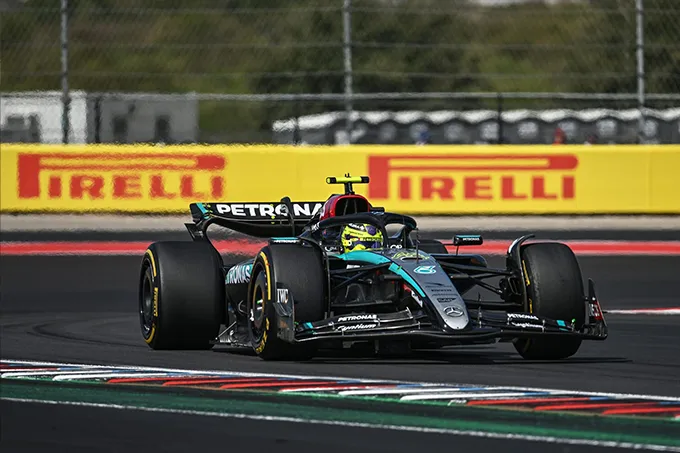James Allison unravels the reasons behind Mercedes’ erratic performance during the unpredictable Austin Grand Prix weekend.
The Austin weekend left Mercedes puzzled. The W15, promising during sprint qualifying, later became unpredictable and inconsistent in both qualifying and the race (as seen with George Russell’s crash in Q3 and Lewis Hamilton’s early race incident).
How to explain this ‘diva’ behavior, a term that has gained traction at Brackley?
The inconsistent performance of the Mercedes W15 at the United States Grand Prix is attributed to a setup that brought the car too close to the ground, according to Technical Director James Allison, who believes the team “pushed the limit too far.”
So, were these just setup mistakes? Or is there a deeper issue with Mercedes F1’s developments, as Lewis Hamilton feared?
James Allison is racking his brain to explain the inconsistency in Austin…
“That’s the million-dollar question.”
“Not only was George close to securing pole, but Lewis was on track to set the fastest times until he got blocked by Franco Colapinto. Why didn’t that performance carry through the rest of the weekend? That’s the big question for us.”
“My guess is that we were flirting too much with the ground. These cars like to run low, and you usually gain lap time by lowering them further, but if you push it too far, the car starts to behave quite unpleasantly.”
“If you hit a bump at the wrong moment, it unsettles the car, causes the rear to break loose, and the performance becomes unpredictable: it’s great when things go well, but punishing at the slightest shock or gust of wind. In my opinion, we pushed the limits a bit too much with ground clearance and the rigidity of the setup.”
Allison also revealed more details about Hamilton’s technical issue with the front-right of his car during the Sprint race.
“Those watching on TV heard Lewis say, ‘I feel a rattling’ as he was preparing for the Sprint. When we took the car apart after the race, where he struggled to find good handling, we discovered that one of the bearings holding a suspension arm was starting to break down. This created some play, causing that rattling sound and inconsistencies in handling, which explained why he felt a looseness in the rear—even though the issue was at the front, it translated into instability.”
The part was replaced before qualifying, though Hamilton still faced difficulties and failed to reach Q2, being knocked out in Q1 for the first time in his career at Austin.
“We replaced the part, and the issue didn’t recur,” Allison confirmed. “It was tough for us to have this problem, and difficult for Lewis to endure a Sprint race like that, but the anomaly was resolved for qualifying and didn’t resurface.”
No new power unit was introduced due to budget cap constraints.
And since Lewis Hamilton was starting from the back of the grid in Austin, why not take the opportunity to start him from the pit lane, change all the settings, and fit a new power unit?
“We could have done what George did, starting from the pit lane after changing the setup between qualifying and the race. But we had no reason to think Lewis’ setup was really problematic. He had his best bodywork pieces, and his grid position was better than starting from the pits. So why not start from where he qualified, even if it wasn’t the place we had hoped for? That was our priority over making setup adjustments.”
As for why Mercedes F1 didn’t install a new power unit in Hamilton’s car, James Allison pointed to budget cap constraints.
“If you change the engine here, you start from the back of the grid, and because of the penalty, you would start from the pit lane. We could have considered that. But more importantly, you can’t just add a new engine without bearing the cost. If your engine fails due to a problem, the rules allow you to get another one without affecting your budget cap. But if you say ‘I want one just because I want one,’ that’s different. You have to pay for it. It wouldn’t have been a good choice. A new ‘fresh’ engine would have improved lap times, but the budget cost didn’t justify the gain.”
- You may also like>Ferrari Eyes Late SF-24 Upgrades Amid Intense F1 Battle
- Also make sure you follow us on social media>Facebook and>Twitter
W15’s Wild Ride: Mercedes Struggles in Austin Showdown W15’s Wild Ride: Mercedes Struggles in Austin Showdown
